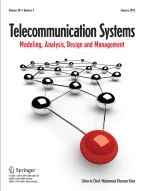Abstract
In a two-way relay communication system, two user terminals (UTs) can communicate and exchange their information data through a relay station by using two timeslots. To realize the two-way relay communication system, each UT is required to estimate channel frequency responses (CFRs) both for up and down links in two timeslots efficiently which be employed in the demodulation of the other user’s information data with frequency domain equalization. To satisfy this requirement, this paper proposes a novel CFR estimation method for the wireless two-way relay communication system of using SFBC MIMO-OFDM technique. The salient feature of proposed CFR estimation method is to employ the maximum likelihood estimation method for the proposed scattered pilot subcarriers assignment which can achieve higher CFR estimation accuracy even in higher time-varying fading channel and when the transmission OFDM signal is sampled by the non-Nyquist rate. In the proposed system, the SFBC technique is also employed for the data subcarriers both for the pilot symbols including data subcarriers and data symbols consisting of all data subcarriers in the frequency axis to improve the bit error rate (BER) performance in the two-way relay system. From the computer simulation results, this paper demonstrates the effectiveness of proposed two-way relay communication system of using SFBC MIMO-OFDM technique. To demonstrate the effectiveness of proposed two-way relay communication system of using SFBC MIMO-OFDM technique, this paper conducts various computer simulations as comparing with the conventional methods in higher time-varying fading channel. From the computer simulation results, this paper confirms that the proposed method even at the non-Nyquist rate can achieve higher channel estimation accuracy evaluated by the normalized mean square error (NMSE) and better BER performances by 5 and 22 times, respectively as comparing with the conventional methods when the normalized Doppler frequency (\(f_dT_S\)) is \(10^{-2}\) and the carrier to noise power ratio (C/N) is 25 dB.








Similar content being viewed by others
Explore related subjects
Discover the latest articles, news and stories from top researchers in related subjects.References
Ahlswede, R., Cai, N., Li, S. Y. R., & Yeung, R. W. (2000). Network information flow. IEEE Transactions on Information Theory, 46(4), 1204–1216.
Katti, S., Gollakota, S.S., & Katabi, D. (2007). Embracing wireless interference: analog nerwork coding. In Proceeding of the Conference on Applications, Technologies, Architectures, and Protocols for Computer Communications, Kyoto.
Prodan, I., Obara, T., Adachi, F., & Gacanin, H. (2011). Pilot-assisted channel estimation without feedback for Bi-directinal broadband ANC. In Proceeding of the 17th Asia-Pacific Conference on Communication. Kota Kinabalu Sabah.
Prodan, I., Obara, T., Adachi, F., & Gacanin, H. (2012). Performance of pilot-assisted channel estimation without feedback for broadband ANC systems using OFDM access. EURASIP Journal on Wireless Communications and Networking. doi:10.1186/1687-1499-2012-315.
Koshimizu, Y., & Okamoto, E. (2012). An effective channel estimation scheme for bi-directional two-timeslots OFDM relay transmission using analog network coding. In Proceeding of IEEE 75th Vehicular Technology Conference, Yokohama.
Koshimizu, Y., & Okamoto, E. (2013). An effective channel estimation scheme using Walsh pilots in bi-directional wireless OFDM relay systems with analog network coding. IEICE Transactions on Communications, E96–B(8), 2119–2130.
Diallo, M., Helard, M., Cariou, L., & Rabineau, R. (2011). Chapter 6: DFT based channel estimation methods for MIMO-OFDM systems. Vehicular Technologies: Increasing Connectivity (pp. 97–114) (Europe:InTech).
Gong, F. K., Zhang, J. K., & Ge, J. H. (2012). Distributed concatenated Alamouti codes for two-way relaying networks. IEEE Wireless Communication Letter, 1(3), 197–200.
Muralidharan, V. T., & Rajan, B. S. (2013). Distributed space time coding for wireless two-way relaying. IEEE Transactions on Signal Processing, 61(4), 981–991.
Ning, X., & Sheng, L. F. (2011). On the performance of two-way relay channels using space-time codes. International Journal of Communication Systems, 24, 1002–1014.
Vu, D.H., Pham, V. B., Tran, X. N., & Ta, C. H. (2014). Design of two way relay network using space-time block coded network coding and linear detection. In Proceeding of IEEE 79th Vehicular Technology Conference , Seoul.
Mata, T., Naito, K., Boonsrimuang, P., Mori, K., & Kobayashi, H. (2013). Proposal of channel estimation method for ITS systems by using STBC MIMO-OFDM. ECTI Transactions on Computer and Information Technology, 8(1), 36–44.
Alamouti, S. M. (1998). A simple transmit diversity technique for wireless communications. IEEE Journal on Selected Areas in Communications, 16(8), 1451–1458.
Kook, L. K., Gok, K. Y., & Hyuk, K. J. (2009). A simple adaptive switching scheme between STBC-OFDM and SFBC-OFDM systems. IEICE Transactions on Communications, E92–B(11), 3546–3549.
Dehghani, M. J., Aravind, R., Jam, S., & Prabhu, K. M. M. (2004). Space-frequency block coding in OFDM systems. In Proceeding of IEEE Region 10 Conference, Bangkok.
Sure, P., & Bhuma, C. M. (2015). A pilot aided channel estimator using DFT based time interpolation for massive MIMO-OFDM systems. AEU International Journal of Electronics and Communications, 69(1), 321–327.
Mata, T., Naito, K., Boonsrimuang, P., Mori, K., & Kobayashi, H. (2014). Proposal of channel estimation method for bi-directional OFDM based ANC in higher time-varying fading channel. In Proceeding of IEEE 79th Vehicular Technology Conference, Seoul.
Acknowledgments
The authors would like to thank to the Japanese Government (Monbukagakusho:MEXT) Scholarships who has supported this research.
Author information
Authors and Affiliations
Corresponding author
Rights and permissions
About this article
Cite this article
Mata, T., Boonsrimuang, P., Mori, K. et al. Proposal of channel estimation method for wireless two-way relay system of using SFBC MIMO-OFDM technique. Telecommun Syst 63, 697–709 (2016). https://doi.org/10.1007/s11235-016-0149-3
Published:
Issue Date:
DOI: https://doi.org/10.1007/s11235-016-0149-3


